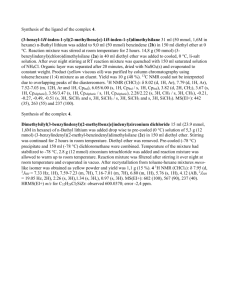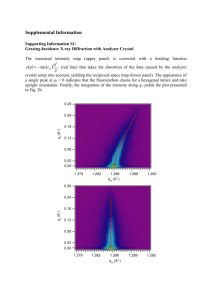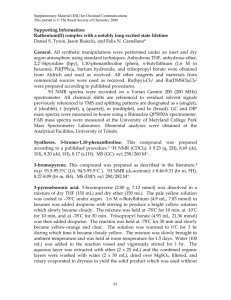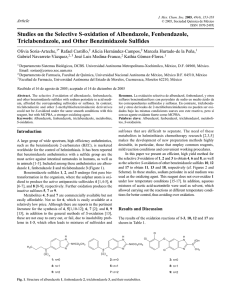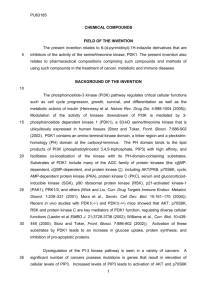Synthesis of the hapten, (2) preparation of hapten conjugate, and (3)
advertisement
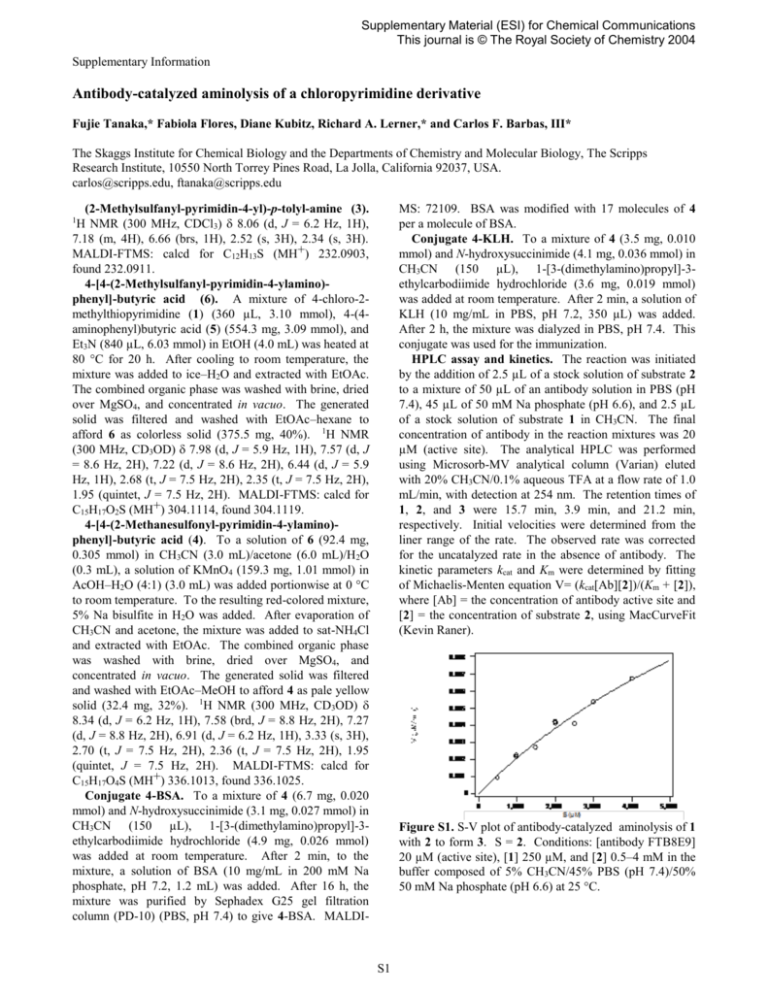
Supplementary Material (ESI) for Chemical Communications This journal is © The Royal Society of Chemistry 2004 Supplementary Information Antibody-catalyzed aminolysis of a chloropyrimidine derivative Fujie Tanaka,* Fabiola Flores, Diane Kubitz, Richard A. Lerner,* and Carlos F. Barbas, III* The Skaggs Institute for Chemical Biology and the Departments of Chemistry and Molecular Biology, The Scripps Research Institute, 10550 North Torrey Pines Road, La Jolla, California 92037, USA. carlos@scripps.edu, ftanaka@scripps.edu (2-Methylsulfanyl-pyrimidin-4-yl)-p-tolyl-amine (3). H NMR (300 MHz, CDCl3) 8.06 (d, J = 6.2 Hz, 1H), 7.18 (m, 4H), 6.66 (brs, 1H), 2.52 (s, 3H), 2.34 (s, 3H). MALDI-FTMS: calcd for C12H13S (MH+) 232.0903, found 232.0911. 4-[4-(2-Methylsulfanyl-pyrimidin-4-ylamino)phenyl]-butyric acid (6). A mixture of 4-chloro-2methylthiopyrimidine (1) (360 µL, 3.10 mmol), 4-(4aminophenyl)butyric acid (5) (554.3 mg, 3.09 mmol), and Et3N (840 µL, 6.03 mmol) in EtOH (4.0 mL) was heated at 80 °C for 20 h. After cooling to room temperature, the mixture was added to ice–H2O and extracted with EtOAc. The combined organic phase was washed with brine, dried over MgSO4, and concentrated in vacuo. The generated solid was filtered and washed with EtOAc–hexane to afford 6 as colorless solid (375.5 mg, 40%). 1H NMR (300 MHz, CD3OD) 7.98 (d, J = 5.9 Hz, 1H), 7.57 (d, J = 8.6 Hz, 2H), 7.22 (d, J = 8.6 Hz, 2H), 6.44 (d, J = 5.9 Hz, 1H), 2.68 (t, J = 7.5 Hz, 2H), 2.35 (t, J = 7.5 Hz, 2H), 1.95 (quintet, J = 7.5 Hz, 2H). MALDI-FTMS: calcd for C15H17O2S (MH+) 304.1114, found 304.1119. 4-[4-(2-Methanesulfonyl-pyrimidin-4-ylamino)phenyl]-butyric acid (4). To a solution of 6 (92.4 mg, 0.305 mmol) in CH3CN (3.0 mL)/acetone (6.0 mL)/H2O (0.3 mL), a solution of KMnO4 (159.3 mg, 1.01 mmol) in AcOH–H2O (4:1) (3.0 mL) was added portionwise at 0 °C to room temperature. To the resulting red-colored mixture, 5% Na bisulfite in H2O was added. After evaporation of CH3CN and acetone, the mixture was added to sat-NH4Cl and extracted with EtOAc. The combined organic phase was washed with brine, dried over MgSO4, and concentrated in vacuo. The generated solid was filtered and washed with EtOAc–MeOH to afford 4 as pale yellow solid (32.4 mg, 32%). 1H NMR (300 MHz, CD3OD) 8.34 (d, J = 6.2 Hz, 1H), 7.58 (brd, J = 8.8 Hz, 2H), 7.27 (d, J = 8.8 Hz, 2H), 6.91 (d, J = 6.2 Hz, 1H), 3.33 (s, 3H), 2.70 (t, J = 7.5 Hz, 2H), 2.36 (t, J = 7.5 Hz, 2H), 1.95 (quintet, J = 7.5 Hz, 2H). MALDI-FTMS: calcd for C15H17O4S (MH+) 336.1013, found 336.1025. Conjugate 4-BSA. To a mixture of 4 (6.7 mg, 0.020 mmol) and N-hydroxysuccinimide (3.1 mg, 0.027 mmol) in CH3CN (150 µL), 1-[3-(dimethylamino)propyl]-3ethylcarbodiimide hydrochloride (4.9 mg, 0.026 mmol) was added at room temperature. After 2 min, to the mixture, a solution of BSA (10 mg/mL in 200 mM Na phosphate, pH 7.2, 1.2 mL) was added. After 16 h, the mixture was purified by Sephadex G25 gel filtration column (PD-10) (PBS, pH 7.4) to give 4-BSA. MALDI- MS: 72109. BSA was modified with 17 molecules of 4 per a molecule of BSA. Conjugate 4-KLH. To a mixture of 4 (3.5 mg, 0.010 mmol) and N-hydroxysuccinimide (4.1 mg, 0.036 mmol) in CH3CN (150 µL), 1-[3-(dimethylamino)propyl]-3ethylcarbodiimide hydrochloride (3.6 mg, 0.019 mmol) was added at room temperature. After 2 min, a solution of KLH (10 mg/mL in PBS, pH 7.2, 350 µL) was added. After 2 h, the mixture was dialyzed in PBS, pH 7.4. This conjugate was used for the immunization. HPLC assay and kinetics. The reaction was initiated by the addition of 2.5 µL of a stock solution of substrate 2 to a mixture of 50 µL of an antibody solution in PBS (pH 7.4), 45 µL of 50 mM Na phosphate (pH 6.6), and 2.5 µL of a stock solution of substrate 1 in CH3CN. The final concentration of antibody in the reaction mixtures was 20 µM (active site). The analytical HPLC was performed using Microsorb-MV analytical column (Varian) eluted with 20% CH3CN/0.1% aqueous TFA at a flow rate of 1.0 mL/min, with detection at 254 nm. The retention times of 1, 2, and 3 were 15.7 min, 3.9 min, and 21.2 min, respectively. Initial velocities were determined from the liner range of the rate. The observed rate was corrected for the uncatalyzed rate in the absence of antibody. The kinetic parameters kcat and Km were determined by fitting of Michaelis-Menten equation V= (kcat[Ab][2])/(Km + [2]), where [Ab] = the concentration of antibody active site and [2] = the concentration of substrate 2, using MacCurveFit (Kevin Raner). 1 Figure S1. S-V plot of antibody-catalyzed aminolysis of 1 with 2 to form 3. S = 2. Conditions: [antibody FTB8E9] 20 µM (active site), [1] 250 µM, and [2] 0.5–4 mM in the buffer composed of 5% CH3CN/45% PBS (pH 7.4)/50% 50 mM Na phosphate (pH 6.6) at 25 °C. S1

